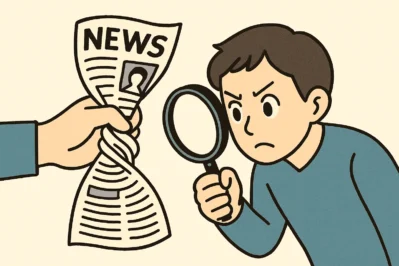Don’t Get Spun! Spotting Bias in Korean Media
Hello! Welcome to Maeil Hangeul, here to upgrade your Korean skills!
Ever read a news article and felt like you were only getting one side of the story? Today, we’re diving into a super important topic for anyone who wants to truly understand Korean society: how to identify and talk about media bias. This is especially useful when you’re reading news about politics, society, or even entertainment.
Lately in Korea, discussions about media fairness are a hot topic, especially online. You’ll see words about “spin” and “distortion” everywhere in news comments and forums. Learning today’s phrases will not only boost your vocabulary but also give you the tools to be a smarter, more critical reader of Korean news. Let’s get started!
Core Expressions You Need to Know
Here are a few key terms to help you pinpoint and discuss media bias like a pro.
1. 왜곡 (Distortion)
- Pronunciation [Romanized]: wae-gok
- English Meaning: Distortion / Falsification
- Detailed Explanation: 왜곡 is a noun that means twisting or distorting the truth. It’s a slightly formal word you’ll frequently encounter in news, articles, and serious discussions. You can combine it with the verb 하다 (to do) to create 왜곡하다 (to distort). It implies a deliberate and serious misrepresentation of facts.
2. 스핀 (Spin)
- Pronunciation [Romanized]: seu-pin
- English Meaning: Spin
- Detailed Explanation: Just like in English, 스핀 is a loanword that refers to the tactic of presenting information in a biased way to create a certain interpretation, usually a favorable one. It’s very common in political contexts. You might hear someone say “이건 언론의 스핀이야” (This is media spin). It feels a bit more modern and conversational than 왜곡.
3. 편향적이다 (To be biased)
- Pronunciation [Romanized]: pyeon-hyang-jeo-gi-da
- English Meaning: To be biased / To be partial
- Detailed Explanation: This is a descriptive verb (adjective) that is essential for this topic. You can use it to describe almost anything you think is unfair or one-sided. For example: 편향적인 보도 (biased reporting), 편향적인 시각 (a biased perspective), or “그 신문은 너무 편향적이야” (That newspaper is too biased).
4. 교묘하게 (Cunningly / Deftly)
- Pronunciation [Romanized]: gyo-myo-ha-ge
- English Meaning: Cunningly / Slyly / Deftly
- Detailed Explanation: This adverb is your secret weapon for adding nuance! It describes how something is distorted. 교묘하게 implies a clever, subtle, and sometimes deceptive manipulation. For example, if a report 교묘하게 omits a key fact, it means it was done skillfully to mislead the reader. Using this word will make your Korean sound much more sophisticated.
Example Dialogue
Let’s see how these words are used in a real conversation between two friends, Sujin and Minjun.
A (Sujin): 민준아, 어제 그 연예 뉴스 봤어? 새로 나온 드라마에 대한 기사 말이야.
(Minjun, did you see that entertainment news yesterday? The article about the new drama.)
B (Minjun): 응, 봤어. 근데 좀 편향적인 것 같지 않아? 경쟁 드라마에 대한 나쁜 점만 강조하더라.
(Yeah, I did. But don’t you think it was a bit biased? It only emphasized the bad things about the competing drama.)
A (Sujin): 맞아. 시청률 같은 중요한 정보는 교묘하게 뺐어. 전형적인 스핀이지.
(Exactly. They cunningly left out important info like viewer ratings. It’s classic spin.)
B (Minjun): 이런 식의 사실 왜곡은 독자들을 혼란스럽게 만들어. 정말 문제야.
(This kind of distortion of facts confuses readers. It’s a real problem.)
Culture Tip & Trend Deep Dive
- Media Literacy in Korea: In Korea, media literacy (미디어 리터러시) is a huge deal. When a major political or social event happens, savvy Koreans will often read articles from news outlets with opposing political leanings (e.g., a conservative paper and a progressive one) to get a more balanced view and spot the 스핀 (spin).
- Spotting Bias in Headlines: A pro tip from Koreans: pay close attention to headlines! If a headline uses very emotional language or strongly leading adjectives instead of neutral facts, it’s often a sign of 편향적인 (biased) reporting.
- Online Commentary: If you browse the comment sections on Naver News or YouTube, you’ll see these words used all the time! People will fiercely debate whether a report is fair or just 왜곡 (distortion). Understanding this vocabulary is your key to unlocking a whole new level of online Korean culture.
Let’s Review and Practice!
Awesome work today! You’ve learned some powerful words—왜곡, 스핀, 편향적이다, and 교묘하게—to help you analyze Korean media with a critical eye.
Now, let’s put your knowledge to the test!
- Fill in the blank:
That politician’s explanation cleverly avoids the main issue. It sounds like ______.
그 정치인의 해명은 교묘하게 핵심을 피하는 것 같아. 이건 ______이야.
(Hint: The English loanword for biased presentation) -
Make a Sentence:
Try creating your own short sentence using 편향적이다 (to be biased). For example, “I try not to read biased articles.”
You did a fantastic job! Now you’re ready to see beyond the headlines. Try leaving a comment below using one of the expressions you learned today! We can’t wait to see your sentences.






